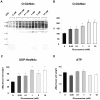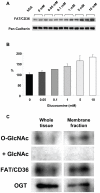Acute regulation of cardiac metabolism by the hexosamine biosynthesis pathway and protein O-GlcNAcylation
- PMID: 21494549
- PMCID: PMC3073970
- DOI: 10.1371/journal.pone.0018417
Acute regulation of cardiac metabolism by the hexosamine biosynthesis pathway and protein O-GlcNAcylation
Abstract
Objective: The hexosamine biosynthesis pathway (HBP) flux and protein O-linked N-acetyl-glucosamine (O-GlcNAc) levels have been implicated in mediating the adverse effects of diabetes in the cardiovascular system. Activation of these pathways with glucosamine has been shown to mimic some of the diabetes-induced functional and structural changes in the heart; however, the effect on cardiac metabolism is not known. Therefore, the primary goal of this study was to determine the effects of glucosamine on cardiac substrate utilization.
Methods: Isolated rat hearts were perfused with glucosamine (0-10 mM) to increase HBP flux under normoxic conditions. Metabolic fluxes were determined by (13)C-NMR isotopomer analysis; UDP-GlcNAc a precursor of O-GlcNAc synthesis was assessed by HPLC and immunoblot analysis was used to determine O-GlcNAc levels, phospho- and total levels of AMPK and ACC, and membrane levels of FAT/CD36.
Results: Glucosamine caused a dose dependent increase in both UDP-GlcNAc and O-GlcNAc levels, which was associated with a significant increase in palmitate oxidation with a concomitant decrease in lactate and pyruvate oxidation. There was no effect of glucosamine on AMPK or ACC phosphorylation; however, membrane levels of the fatty acid transport protein FAT/CD36 were increased and preliminary studies suggest that FAT/CD36 is a potential target for O-GlcNAcylation.
Conclusion/interpretation: These data demonstrate that acute modulation of HBP and protein O-GlcNAcylation in the heart stimulates fatty acid oxidation, possibly by increasing plasma membrane levels of FAT/CD36, raising the intriguing possibility that the HBP and O-GlcNAc turnover represent a novel, glucose dependent mechanism for regulating cardiac metabolism.
Conflict of interest statement
Figures





Similar articles
-
First characterization of glucose flux through the hexosamine biosynthesis pathway (HBP) in ex vivo mouse heart.J Biol Chem. 2020 Feb 14;295(7):2018-2033. doi: 10.1074/jbc.RA119.010565. Epub 2020 Jan 8. J Biol Chem. 2020. PMID: 31915250 Free PMC article.
-
Increased hexosamine biosynthesis and protein O-GlcNAc levels associated with myocardial protection against calcium paradox and ischemia.J Mol Cell Cardiol. 2006 Feb;40(2):303-12. doi: 10.1016/j.yjmcc.2005.11.003. Epub 2005 Dec 9. J Mol Cell Cardiol. 2006. PMID: 16337959
-
Glutamine-induced protection of isolated rat heart from ischemia/reperfusion injury is mediated via the hexosamine biosynthesis pathway and increased protein O-GlcNAc levels.J Mol Cell Cardiol. 2007 Jan;42(1):177-85. doi: 10.1016/j.yjmcc.2006.09.015. Epub 2006 Oct 27. J Mol Cell Cardiol. 2007. PMID: 17069847 Free PMC article.
-
The Hexosamine Biosynthesis Pathway: Regulation and Function.Genes (Basel). 2023 Apr 18;14(4):933. doi: 10.3390/genes14040933. Genes (Basel). 2023. PMID: 37107691 Free PMC article. Review.
-
Hexosamine biosynthesis and protein O-glycosylation: the first line of defense against stress, ischemia, and trauma.Shock. 2008 Apr;29(4):431-40. doi: 10.1097/shk.0b013e3181598bad. Shock. 2008. PMID: 17909453 Review.
Cited by
-
Metabolic effects of glutamine on the heart: anaplerosis versus the hexosamine biosynthetic pathway.J Mol Cell Cardiol. 2013 Feb;55:92-100. doi: 10.1016/j.yjmcc.2012.11.008. Epub 2012 Nov 28. J Mol Cell Cardiol. 2013. PMID: 23201305 Free PMC article.
-
Cardiac Molecular Analysis Reveals Aging-Associated Metabolic Alterations Promoting Glycosaminoglycans Accumulation via Hexosamine Biosynthetic Pathway.Adv Sci (Weinh). 2024 Oct;11(38):e2309211. doi: 10.1002/advs.202309211. Epub 2024 Aug 9. Adv Sci (Weinh). 2024. PMID: 39119859 Free PMC article.
-
c-Myc Alters Substrate Utilization and O-GlcNAc Protein Posttranslational Modifications without Altering Cardiac Function during Early Aortic Constriction.PLoS One. 2015 Aug 12;10(8):e0135262. doi: 10.1371/journal.pone.0135262. eCollection 2015. PLoS One. 2015. PMID: 26266538 Free PMC article.
-
C-Myc induced compensated cardiac hypertrophy increases free fatty acid utilization for the citric acid cycle.J Mol Cell Cardiol. 2013 Feb;55:156-64. doi: 10.1016/j.yjmcc.2012.07.005. Epub 2012 Jul 22. J Mol Cell Cardiol. 2013. PMID: 22828478 Free PMC article.
-
Nox4 reprograms cardiac substrate metabolism via protein O-GlcNAcylation to enhance stress adaptation.JCI Insight. 2017 Dec 21;2(24):e96184. doi: 10.1172/jci.insight.96184. JCI Insight. 2017. PMID: 29263294 Free PMC article.
References
-
- An D, Rodrigues B. Role of changes in cardiac metabolism in development of diabetic cardiomyopathy. Am J Physiol Heart Circ Physiol. 2006;291:H1489–1506. - PubMed
-
- Boudina S, Abel ED. Diabetic cardiomyopathy revisited. Circulation. 2007;115:3213–3223. - PubMed
-
- Randle PJ, Garland PB, Hales CN, Newsholme EA. The glucose fatty-acid cycle: Its role in insulin sensitivity and metabolic disturbances of diabetes mellitus. The Lancet. 1963;1:785–789. - PubMed
-
- Buchanan J, Mazumder PK, Hu P, Chakrabarti G, Roberts MW, et al. Reduced cardiac efficiency and altered substrate metabolism precedes the onset of hyperglycemia and contractile dysfunction in two mouse models of insulin resistance and obesity. Endocrinology. 2005;146:5341–5349. - PubMed
-
- Torres CR, Hart GW. Topography and polypeptide distribution of terminal N-acetylglucosamine residues on the surfaces of intact lymphocytes. Evidence for O-linked GlcNAc. J Biol Chem. 1984;259:3308–3317. - PubMed
Publication types
MeSH terms
Substances
Grants and funding
LinkOut - more resources
Full Text Sources
Other Literature Sources
Miscellaneous

